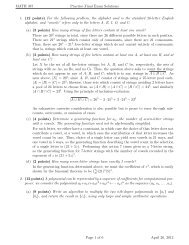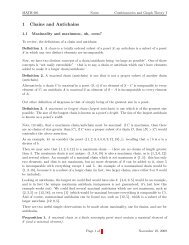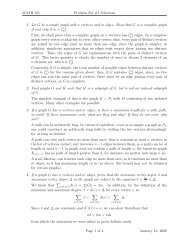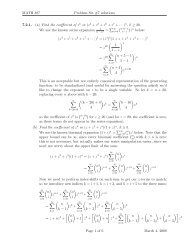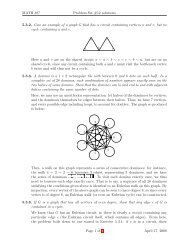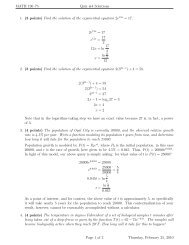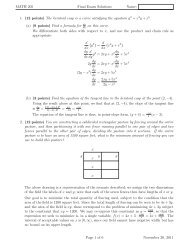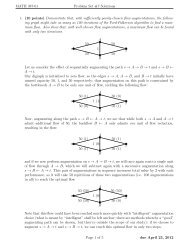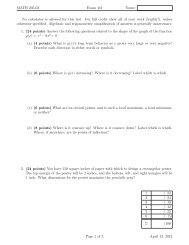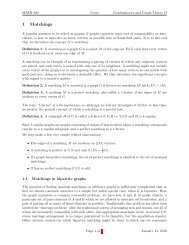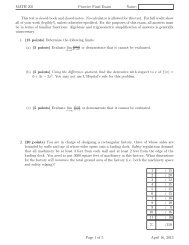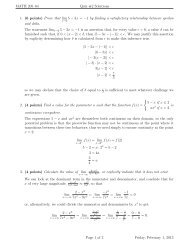MATH 205-04 Practice Exam #3 Name: No calculator is allowed for ...
MATH 205-04 Practice Exam #3 Name: No calculator is allowed for ...
MATH 205-04 Practice Exam #3 Name: No calculator is allowed for ...
Create successful ePaper yourself
Turn your PDF publications into a flip-book with our unique Google optimized e-Paper software.
<strong>MATH</strong> <strong>205</strong>-<strong>04</strong> <strong>Practice</strong> <strong>Exam</strong> <strong>#3</strong> <strong>Name</strong>:<br />
<strong>No</strong> <strong>calculator</strong> <strong>is</strong> <strong>allowed</strong> <strong>for</strong> th<strong>is</strong> test. For full credit show all of your work (legibly!), unless<br />
otherw<strong>is</strong>e specified. Algebraic and trigonometric simplification of answers <strong>is</strong> generally unnecessary.<br />
1. (24 points) Answer the following questions related to the shape of the graph of the function<br />
g(x) = x 4 − 8x 2 + 8.<br />
(a) (4 points) What <strong>is</strong> g(x)’s long term behavior as x grows very large or very negative?<br />
Describe each direction in either words or symbols.<br />
(b) (6 points) Where <strong>is</strong> g(x) increasing? Where <strong>is</strong> it decreasing? Label which <strong>is</strong> which.<br />
(c) (6 points) What are its critical points, and <strong>is</strong> each a local maximum, a local minimum,<br />
or neither?<br />
(d) (8 points) Where <strong>is</strong> it concave up? Where <strong>is</strong> it concave down? Label which <strong>is</strong> which.<br />
Where, if anywhere, are its points of inflection?<br />
2. (24 points) You have 150 square inches of paper with which to design a rectangular poster.<br />
The top margin of the poster will be 2 inches, and the bottom, left, and right margins will be<br />
1 inch. What dimensions <strong>for</strong> the poster maximize the printable area?<br />
1 / 24<br />
2 / 24<br />
3 / 13<br />
4 / 12<br />
5 / 22<br />
Σ /100<br />
Page 1 of 3 April 5, 2013
<strong>MATH</strong> <strong>205</strong>-<strong>04</strong> <strong>Practice</strong> <strong>Exam</strong> <strong>#3</strong><br />
3. (13 points) Answer the following questions:<br />
(a) (7 points) Find f(x) given that f ′ (x) = 16x 3 − 3x 2 and f(1) = 4.<br />
(b) (8 points) Find the general antiderivative of h(t) = 6√ t + 5 t − 2 + 4 csc2 t − 5<br />
1+t 2 .<br />
4. (12 points) Answer the following questions about approximation:<br />
(a) (6 points) Starting with an initial value of 1, use two iterations of Newton’s method<br />
to approximate a zero of f(x) = x 6 − 5x + 3. Your answer need not be arithmetically<br />
simplified.<br />
(b) (6 points) Choose x 1 = 4 to be an initial approximation of √ 17. Use one step of<br />
Newton’s method on an appropriately chosen polynomial function to develop x 2 , a better<br />
rational approximation of √ 17; also give an arithmetic expression (which need not<br />
be simplified) <strong>for</strong> the better approximation x 3 ar<strong>is</strong>ing from a second step of Newton’s<br />
method.<br />
Page 2 of 3 April 5, 2013
<strong>MATH</strong> <strong>205</strong>-<strong>04</strong> <strong>Practice</strong> <strong>Exam</strong> <strong>#3</strong><br />
5. (22 points) Evaluate the following limits; if they cannot be evaluated, show why not.<br />
(a) lim<br />
x→0<br />
6x<br />
. arctan x<br />
θ+sin θ<br />
(b) lim .<br />
θ→0<br />
θ+cos θ<br />
(c)<br />
e<br />
lim<br />
u/10<br />
.<br />
u→+∞ u 3<br />
sin x−x<br />
(d) lim .<br />
x→0 x 2 e x<br />
(e) lim<br />
x→1<br />
ln x<br />
x 2 −2x+1 . Page 3 of 3 April 5, 2013




